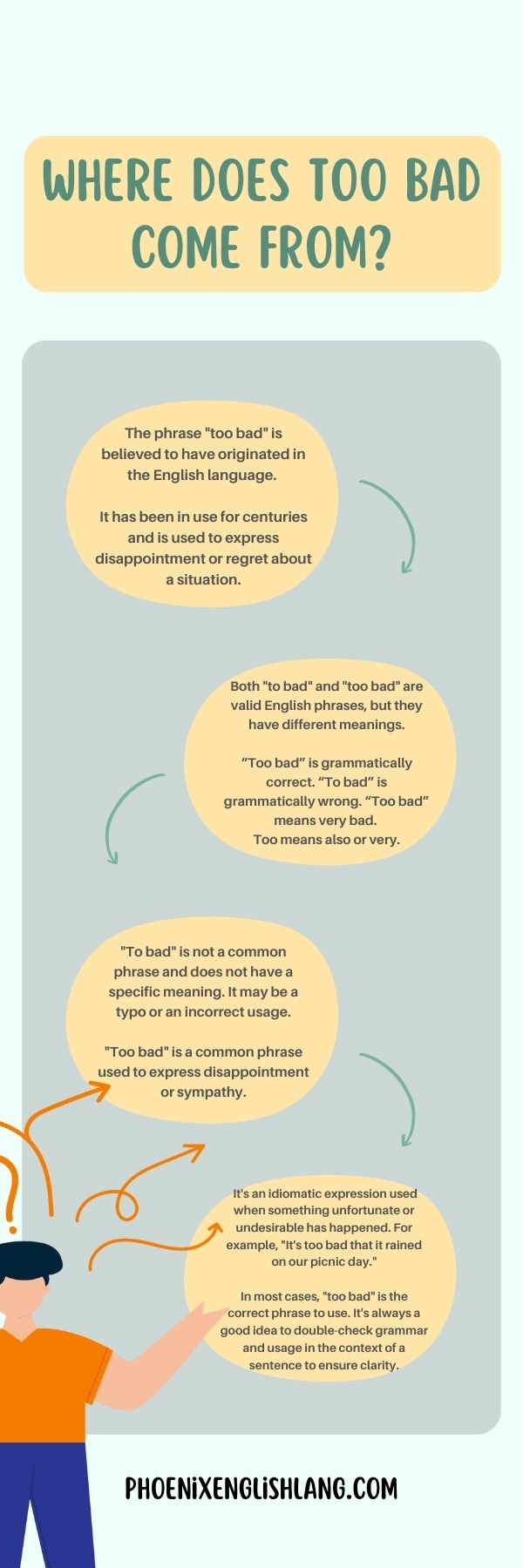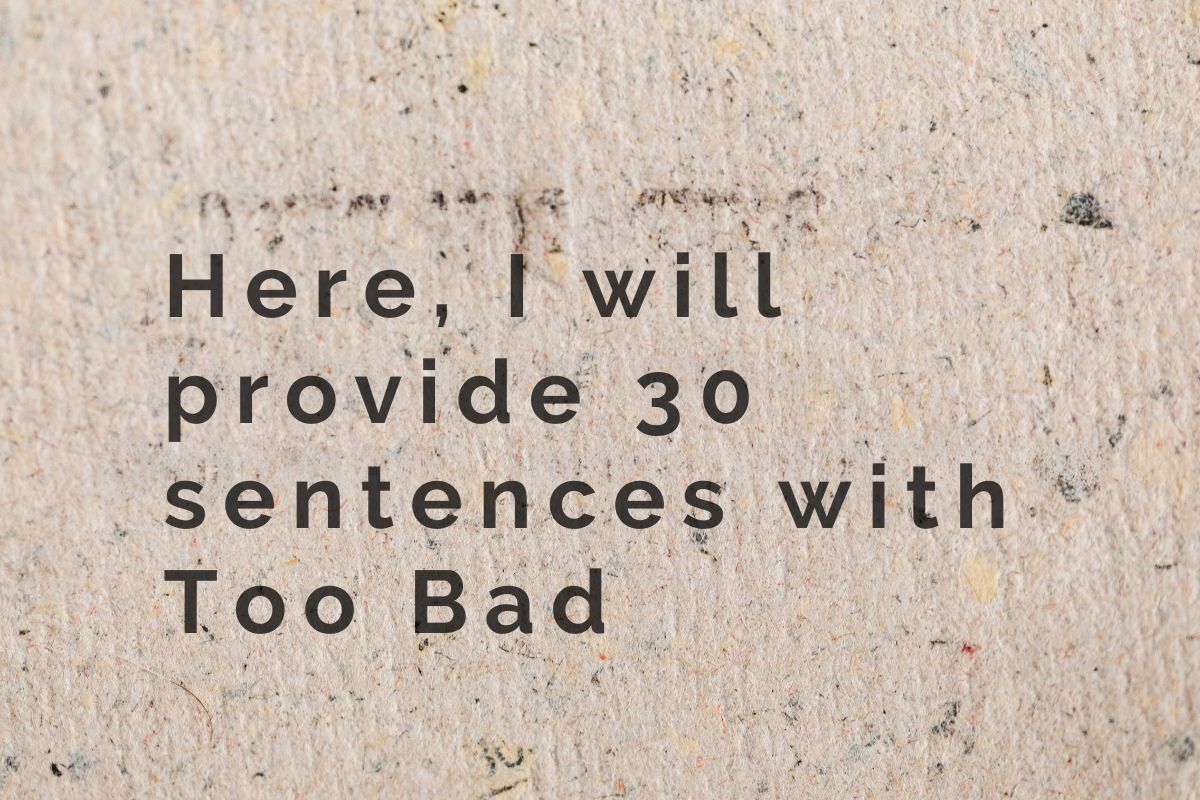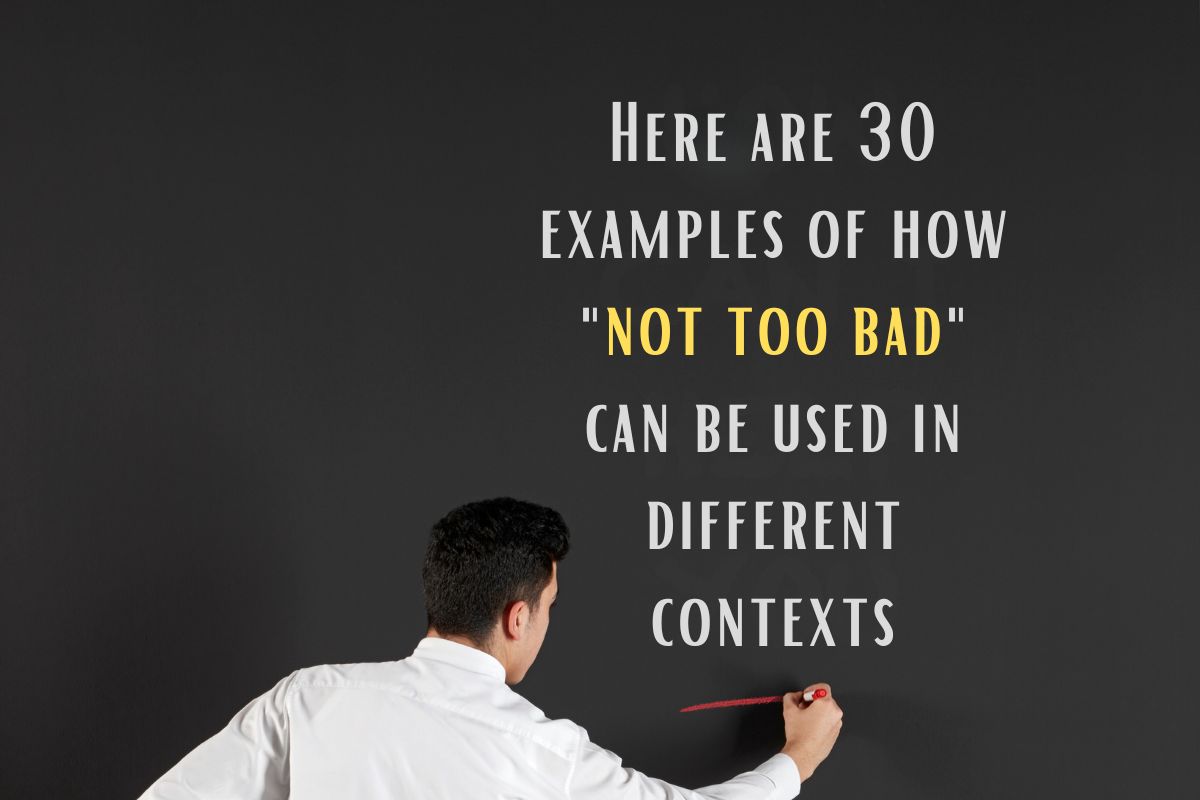In the realm of English grammar and usage, the distinction between “to bad” and “too bad” often becomes a point of confusion for many. So, what’s the correct form? The answer is “too bad.”
The phrase “too bad” functions as an idiomatic expression that conveys disappointment or regret about a situation, suggesting that something is unfortunate or lesser than desired.
On the other hand, “to bad” is not a grammatically correct construction in standard English and typically serves as an error stemming from a misunderstanding of the phrase’s intended meaning.

In this guide titled “Too Bad Or To Bad – Correct Grammar + Examples [2025],” we will delve into the nuances of this common expression, clarifying its correct usage while also providing context and examples that illustrate its application in everyday conversations.
Understanding the correct form is crucial not only for effective communication but also for avoiding potential misunderstandings that could arise from using the incorrect phrase.
As we further explore this topic, we will differentiate between various contexts in which “too bad” appears, examining its role in informal and formal communication.
We will also discuss how this phrase fits into broader expressions of sentiment, helping readers appreciate the subtlety of language that indicates disappointment or resignation.
Additionally, we will provide examples that showcase the phrase’s versatility in various scenarios, from casual conversations to literary use.
Our journey will also address some common misconceptions surrounding the phrase, including instances where people might mistakenly interchange it with similar-sounding constructs, and the importance of context in determining meaning.
By the end of this guide, readers will have a clear understanding of how to use “too bad” correctly, empowering them to articulate their thoughts and feelings more effectively in English.
Let’s embark on this exploration of grammar that, while seemingly simple, plays a significant role in clear and effective communication.
You might also enjoy: Top 100 Commonly Used Verbs That Start With D [2024]
Definitions
To: This word serves primarily as a preposition indicating direction, place, person, or thing. It can also function as a part of an infinitive verb form (to + verb). Understanding this dual role is crucial for correct usage.
Too: An adverb indicating “excessively” or “more than necessary.” It can also mean “also” when used in a sentence. Recognizing this adverb’s meaning will help in distinguishing it from “to.”
Usage of “To”
Direction: When conveying movement toward a place, “to” specifies the direction of that movement.
Example: “She walked to the store.” (implies the store was the destination)
Infinitive Verb: Incorporating “to” with a verb creates an infinitive, which is used to express an action or state.
Example: “He wants to play soccer.” (“to play” expresses the intent of the action)
Indicating Time: Use “to” to specify time periods, showing the span from one point to another.
Example: “The event runs from 10 AM to 4 PM.” (implies a range)
Indicating Purpose: “To” often indicates the purpose of an action, clarifying why something is done.
Example: “I called to confirm the appointment.” (the reason for calling)
Indicating Limit: “To” can denote a maximum point or limit reached in a context.
Example: “The population grew to 1 million.” (indicates the reached population count)
Destination in Travel: It clarifies the final destination in travel-related contexts.
Example: “We traveled to London last summer.” (indicates the place visited)
Usage of “Too”
Excessiveness: This adverb emphasizes that something exceeds an acceptable limit.
Example: “That cake is too sweet.” (suggests the sweetness is overwhelming)
Also: Here, “too” is synonymous with “also,” indicating inclusion.
Example: “I’ll join you too.” (means “I’ll join you as well”)
Limitations: Use “too” to describe a point beyond which something becomes unacceptable or impractical.
Example: “It’s too cold to swim.” (implies that the temperature is below a viable limit)
Negative Connotation: Frequently, “too” introduces negative situations or limits.
Example: “She’s too busy to help.” (implies her busyness prevents her from assisting)
Distinctions and Confusion
Common Confusion: Since “to” and “too” are phonetically similar, they can often be misused. Recognizing their functions helps mitigate these errors.
Incorrect Usage Example: Incorrectly substituting “too” for “to”:
“I was too busy to study.” (correct)
“I was to busy to study.” (incorrect)
Context-Specific Examples
Travel Context:
“I want to travel to Japan next year.” (correctly indicates future intention and destination)
Food Context:
“It’s too spicy for my taste.” (indicates that the spice level exceeds comfort)
Social Context:
“He is too shy to speak in public.” (describes a limitation based on his shyness)
Academic Context:
“This material is too difficult to understand.” (suggests it exceeds comprehension)
Fitness Context:
“I like to jog too.” (indicates shared interest in jogging alongside another activity)
More Nuanced Examples
Dramatic Context:
“The storyline was too complex for casual viewers.” (describes an excess in complexity)
Emotional Context:
“I felt too overwhelmed to make a decision.” (implies paralysis by analysis)
Professional Context:
“The risk was too high to proceed with the investment.” (indicates crossing an acceptable risk threshold)
Cultural Context:
“The venue was too small to accommodate everyone.” (describes a limitation in space)
You might also enjoy:Looking Forward To Seeing You: Grammar + Examples[2025]
Usage in Questions
Questioning Limitations:
“Is it too late to change our reservations?” (queries about the acceptability of timing)
Asking for Direction:
“Could you guide me to the nearest station?” (seeking direction)
Understanding Implications
Expressing Regret: “I wish I had gone to that concert; it was too good.” (indicates a missed opportunity and its high quality)
Plans and Goals: “I need to save money to travel next year.” (“to travel” explains the intention behind saving)
Feedback and Reactions:
“The movie is too long for my taste.” (suggests its duration exceeds personal preference)
Effective in Arguments: Using “to” can ground an argument in logical premises.
“To succeed, one must practice regularly.” (indicates that regular practice is necessary)
Writing Techniques
Formal Writing: In scholarly articles or formal documents, consistently use “to” for clarity and correctness.
Creative Writing:
“She was too excited to contain her joy.” (creates a vivid emotional image)
Persuasive Writing:
“We must act to address climate change effectively.” (establishes urgency and purpose)
Peer Review and Editing
Proofreading: When reviewing work, check for the incorrect use of “to” and “too.” A common exercise is to read the text aloud to identify errors easily.
Feedback: Engage in peer review sessions focusing on common grammatical pitfalls, including the misuse of “to” and “too.”
Communication and Clarity
Verbal Communication: Emphasizing pronunciation and the differences during verbal communication can help others grasp correct usage.
In Academic Discussions: Using the correct form during formal discussions demonstrates expertise and aids clear understanding among participants.
Common Mistakes and Learning
Frequent Errors:
“He’s too tired to go.” (correct)
“He’s to tired to go.” (incorrect usage by mixing them up)
Learning Tools: Incorporate games or quizzes on distinguishing “to” and “too” for engagement, like flashcards or online exercises.
Exercises for Practice
Fill-in-the-Blank: Create worksheets that ask students to fill in sentences with either “to” or “too” based on context clues.
Peer Teaching: Encourage students to explain the difference to each other, reinforcing their understanding through teaching.
Final Reflections
Importance in Daily Communication: Misusing “to” and “too” can lead to misunderstandings in everyday conversations, highlighting the significance of mastery.
Reflecting on Language Proficiency: Correct usage of “to” and “too” is a marker of language proficiency, which can impact both personal and professional interactions.
You might also enjoy:Emersion Vs Immersion: Meaning, Differences, and Examples
Writing Resources
Guidelines: Reference style guides regularly (like the APA or MLA) for official instructions on the proper usage of these terms.
Online Resources: Websites such as Grammarly or Purdue OWL can provide explanations and practice exercises for honing grammar skills.
Language Evolution
Changing Language Use: Language shifts over time. Being aware of how “to” and “too” fit within modern communication ensures relevance.
Cultural Context
Regional Differences: Informal expressions and slang may allow for “too” to be misused, so understanding diverse contexts is crucial.
Practicing Dialogue
Script Exercises: Write dialogues that incorporate various uses of “to” and “too” to illustrate their differences through context.
Memory Aids
Mnemonic Devices: Create interesting mnemonics to remember the differences—e.g., “To is a path; Too is an excess.”
Essential Language Skill: Mastering the differences between “to” and “too” is paramount for effective communication, reflecting attention to detail and language competence.
You might also enjoy:Where Does “How is your Day Going?” Originate From?
49 points of the phrase too bad
- “Too bad” is a common expression used to express sympathy or disappointment.
- It can be used in response to unfortunate news or situations.
- The phrase implies a sense of regret or sadness.
- It can be used to show empathy towards someone’s misfortune.
- The phrase is versatile and can be used in various contexts.
- It is a concise way to convey disappointment.
- “Too bad” is a polite way to express sympathy.
- The phrase is commonly used in English-speaking countries.
- It can be used in both formal and informal settings.
- “Too bad” is a simple and effective way to acknowledge someone’s disappointment.
- The phrase can be used to express regret over missed opportunities.
- It is a useful expression in everyday conversations.
- “Too bad” can be used to show understanding and compassion.
- The phrase is often used to console someone who is facing a setback.
- It is a culturally accepted way to express sympathy.
- “Too bad” can be used to express disappointment without being overly emotional.
- The phrase is easy to understand and widely recognized.
- It is a common response to unfortunate events.
- “Too bad” can be used to show support for someone going through a tough time.
- The phrase is a way to acknowledge someone’s feelings without offering solutions.
- It is a non-judgmental way to respond to someone’s misfortune.
- “Too bad” can be used to express solidarity with someone facing challenges.
- The phrase is a way to show that you care about someone’s well-being.
- It is a respectful way to acknowledge someone’s struggles.
- “Too bad” can be used to express disappointment over a negative outcome.
- The phrase is a way to show empathy towards others.
- It is a common expression in everyday conversations.
- “Too bad” can be used to express sympathy towards someone’s loss.
- The phrase is a way to show that you are listening and understanding someone’s feelings.
- It is a polite way to respond to someone’s difficulties.
- “Too bad” can be used to offer comfort to someone in distress.
- The phrase is a way to show that you care about someone’s feelings.
- It is a simple and effective way to express empathy.
- “Too bad” can be used to acknowledge someone’s struggles without minimizing their experiences.
- The phrase is a way to show that you are there for someone in tough times.
- It is a respectful way to respond to someone’s challenges.
- “Too bad” can be used to express disappointment over a negative turn of events.
- The phrase is a way to show that you understand and respect someone’s emotions.
- It is a common expression in conversations about difficult situations.
- “Too bad” can be used to express solidarity with someone facing adversity.
- The phrase is a way to show that you are supportive of someone’s struggles.
- It is a polite way to acknowledge someone’s difficulties.
- “Too bad” can be used to offer encouragement to someone going through a tough time.
- The phrase is a way to show that you are there for someone in need.
- It is a simple and compassionate way to respond to someone’s challenges.
- “Too bad” can be used to express understanding and compassion towards others.
- The phrase is a way to show that you care about someone’s well-being.
- It is a respectful way to acknowledge someone’s hardships.
- “Too bad” is a versatile expression that can be used to express sympathy and support in various situations.
Where does Too Bad come from?

The phrase “too bad” is believed to have originated in the English language. It has been in use for centuries and is used to express disappointment or regret about a situation.
Both “to bad” and “too bad” are valid English phrases, but they have different meanings.
“Too bad” is grammatically correct. “To bad” is grammatically wrong. “Too bad” means very bad. Too means also or very.
“To bad” is not a common phrase and does not have a specific meaning. It may be a typo or an incorrect usage.
“Too bad” is a common phrase used to express disappointment or sympathy. It’s an idiomatic expression used when something unfortunate or undesirable has happened. For example, “It’s too bad that it rained on our picnic day.”
In most cases, “too bad” is the correct phrase to use. It’s always a good idea to double-check grammar and usage in the context of a sentence to ensure clarity.
Additional Contextual Examples
In Literature: Explore how authors convey disappointment or regret through characters’ dialogue using “too bad.”
Example: A character in a novel might say, “It’s too bad the adventure ended so abruptly,” showcasing a narrative context where the phrase emphasizes feelings of loss.
In Customer Service: Discuss how “too bad” might be used in customer service scenarios when a service or product does not meet expectations.
Example: A customer support representative could say, “I’m sorry to hear you’re unhappy with your purchase; that’s too bad. Let me help you resolve it.”
You Might Also Enjoy: Top 60 Most Common Simple Sentences In English
Nuances in Tone
Differentiating Sympathy and Sarcasm: “Too bad” can convey genuine sympathy or sarcasm depending on tone and context.
Example: “Oh, too bad you forgot your umbrella!” can be sarcastic if the speaker is teasing someone about being unprepared.
Non-verbal Communication: Explain how body language or facial expressions can change the meaning of “too bad.”
Example: A sincere frown when saying “too bad” conveys empathy, while a smirk might imply the speaker is mocking the other person’s misfortune.
Cultural Variations
International Usage: Examine how the phrase “too bad” is perceived in different cultures or languages.
Example: In some cultures, expressions of sympathy may be more elaborate, so simply saying “too bad” could be viewed as insufficient.
Phrase Evolution: Discuss how the expression “too bad” may have evolved in contemporary language, especially with the rise of social media and texting, where brevity is prioritized.
Example: “TBH, that’s too bad!” is an example of informal shorthand used among younger generations.
Variations in Written Forms
Use in Different Writing Styles: Discuss how the phrase “too bad” might be adapted for various types of writing, such as academic, creative, or business writing.
Example: In a formal essay, one might use “regrettably” instead of “too bad” to maintain a professional tone.
Creative Uses: Illustrate how authors and poets may use “too bad” for creative purposes, employing it metaphorically within their work.
Example: “In the garden of dreams, it’s too bad the flowers wilted too soon” can evoke strong imagery while expressing regret.
You might also enjoy:Interested In or On: The Differences + Examples [2025]
Common Mistakes with “Too Bad”
Misinterpretation with Similar Phrases: Discuss how “too bad” is often confused with expressions like “not too bad,” which can convey a different sentiment.
Example: Clarifying that “not too bad” suggests a positive or acceptable situation, while “too bad” indicates disappointment.
Colloquial Misuse: Point out that some may mistakenly use “too bad” in inherently positive situations, leading to confusion.
Example: “It’s too bad that you won the prize!” is incorrect as “too bad” implies regret, while the situation is positive.
Historical Context
Etymology and Usage Over Time: Discuss the historical roots of the phrase “too bad” and how its meanings have shifted over time, reflecting changes in social norms and values.
Example: The phrase’s usage in older literary works compared to modern dialogues can illustrate shifts in language.
Dimensional Perspective
Emotional Spectrum: Explore the emotional spectrum of using “too bad” and how it might vary from light-hearted disappointment to serious sympathy.
Example: Using “too bad” in a light-hearted context with friends may differ from its use in a serious conversation about loss.
Contextual Acceptance: Dive into how the acceptability of using “too bad” varies by context, and potentially provide examples of when it might be seen as appropriate or inappropriate.
Example: “That was too bad” might be seen as dismissive in a discussion about serious matters, whereas it works in casual conversations.
You might also enjoy:How Are You Fairing or Faring? Differences + Examples
Here, I will provide 30 sentences with Too Bad

1. It’s too bad that I missed the bus this morning.
2. Too bad the weather ruined our plans for a beach day.
3. I couldn’t attend the concert, and that’s too bad.
4. It’s too bad that she didn’t get the promotion she was hoping for.
5. We were out of town when our favourite band performed. Too bad!
6. Too bad you didn’t win the lottery. Maybe next time!
7. It’s too bad that the restaurant was closed when we arrived.
8. I dropped my phone and now the screen is cracked. Too bad!
9. Too bad he didn’t apologise for his rude behaviour.
10. I missed the sale at my favourite store. Too bad for me.
11. It’s too bad that the movie ended with such a confusing plot twist.
12. Too bad you couldn’t see the fireworks display. It was magnificent.
13. I wanted to try that new ice cream flavour, but they were sold out. Too bad!
14. It’s too bad that he couldn’t join us for the family gathering.
15. Too bad the car broke down on our road trip.
16. I can’t make it to your birthday party. Too bad, I was really looking forward to celebrating with you.
17. It’s too bad that our flight got delayed, we might miss our connecting flight.
18. Too bad I forgot my umbrella, and now I’m stuck in the rain.
19. We couldn’t find seats for the concert. Too bad, we were excited to see the band.
20. It’s too bad that she didn’t get a chance to say goodbye before moving away.
21. Too bad the bakery ran out of the cake we wanted for the party.
22. I failed my driving test. Too bad, I’ll have to retake it.
23. It’s too bad that they canceled the game due to bad weather.
24. Too bad we ran out of milk, now I can’t make my favourite dessert.
25. I wanted to take a vacation, but I couldn’t get time off work. Too bad!
26. It’s too bad that I forgot to save my progress in the video game.
27. Too bad the train was delayed, I’ll be late for the meeting.
28. I tripped and spilled coffee all over my new shirt. Too bad!
29. It’s too bad she didn’t get a chance to meet her favourite celebrity at the event.
30. Too bad the store closed early, I needed to buy some groceries.
You might also enjoy:Too Cute Meaning Vs To Cute (To Vs Too) + Examples
Here are a few examples of how “too bad” can be used in different contexts

1. In a sympathetic context:
– Friend: “I didn’t pass the exam.”
– You: “Oh, too bad. I know how hard you studied.”
2. In a casual, dismissive context:
– Co-worker: “I can’t make it to the meeting today.”
– You: “Too bad, we’ll catch you up later.”
3. In a regretful context:
– Student: “I missed the deadline for the scholarship application.”
– Counsellor: “Too bad. Let’s look for other opportunities.”
In each of these examples, “too bad” conveys a different nuance depending on the situation and the speaker’s tone.
The phrase “too bad” is generally considered informal, and it is often used in casual conversation.
It is commonly employed to express sympathy, disappointment, or to acknowledge an unfortunate situation in a conversational or relaxed setting.
While it may be suitable for everyday communication and informal writing, it may come across as too casual for formal or professional contexts.
In more formal situations, one might choose alternative expressions such as “unfortunate,” “regrettable,” or “disappointing.”
Here are some alternative phrases you can use instead of “too bad”
Let’s Stick Around a Bit Longer
- After the concert, I felt the energy in the crowd and suggested, “Let’s stick around a bit longer and enjoy the vibes.”
- Even though it was getting late, I proposed to my friends, “Let’s stick around a bit longer; the sunset is going to be beautiful!”
- While waiting for the food delivery, I said, “Let’s stick around a bit longer; we might catch a glimpse of our neighbors’ party.”
You might also enjoy:How Are You Fairing or Faring? Differences + Examples
Why Don’t We Stay Put for a While
- As the rain started pouring, I suggested, “Why don’t we stay put for a while until it lets up a bit?”
- While sitting in the cozy café, I smiled and said, “Why don’t we stay put for a while and enjoy another cup of coffee?”
- Observing the stunning view from the hilltop, I remarked, “Why don’t we stay put for a while and take some pictures?”
How about Hanging Out Here a Little Longer
- As the stars began to twinkle, I turned to my friends and asked, “How about hanging out here a little longer to enjoy the night sky?”
- After finishing our meal, I suggested, “How about hanging out here a little longer since the ambiance is so relaxing?”
- Noticing the laughter and fun, I said, “How about hanging out here a little longer? We’re having such a great time!”
Let’s Not Rush Off, Shall We
- As the movie credits began to roll, I urged, “Let’s not rush off, shall we? I want to hear your thoughts on the film.”
- While enjoying dessert, I proposed, “Let’s not rush off, shall we? This cake is too delicious to leave behind so soon.”
- Seeing everyone deep in conversation, I suggested, “Let’s not rush off, shall we? We can catch up a bit more.”
Maybe We Should Enjoy the Scene for a Bit
- Standing at the edge of the viewpoint, I suggested, “Maybe we should enjoy the scene for a bit before heading back.”
- As we explored the art gallery, I remarked, “Maybe we should enjoy the scene for a bit; these paintings are truly inspiring.”
- After a long hike, I sighed, “Maybe we should enjoy the scene for a bit—it’s not every day you get to see such a breathtaking landscape.”
Why Don’t We Extend Our Time Here
- Noticing how much fun we were having, I asked, “Why don’t we extend our time here and try another activity?”
- Enjoying the warm weather, I suggested, “Why don’t we extend our time here at the beach for a few more hours?”
- After a great conversation with friends, I proposed, “Why don’t we extend our time here a little longer to catch up some more?”
Let’s Linger a While Longer
- With a warm cup of tea in hand, I said, “Let’s linger a while longer and enjoy the cozy atmosphere of this café.”
- Watching the sunset, I suggested, “Let’s linger a while longer to savor this beautiful moment together.”
- As the music played softly, I smiled and said, “Let’s linger a while longer; this song is perfect for this moment.”
No Need to Hurry Away, Right
- As we settled into our picnic spot, I reassured everyone, “No need to hurry away, right? We have plenty of time to relax.”
- In the tranquil garden, I said, “No need to hurry away, right? We can take our time and enjoy the peaceful surroundings.”
- Feeling the warmth of the fire, I remarked, “No need to hurry away, right? Let’s savor this evening a bit more.”
You might also enjoy:What Kind of Vs What Kinds of – Differences + Examples [2025]
How about Not Leaving Just Yet
- With laughter still echoing around us, I suggested, “How about not leaving just yet? The night is still young.”
- As we finished our drinks, I said, “How about not leaving just yet? I want to hear more of your stories.”
- When the music started to pick up again, I exclaimed, “How about not leaving just yet? The party is just getting started!”
Let’s Soak in the Atmosphere a Little More
- After arriving at the bustling festival, I said, “Let’s soak in the atmosphere a little more before heading to the next event.”
- While standing in the vibrant market, I suggested, “Let’s soak in the atmosphere a little more; there’s so much to explore.”
- As we enjoyed the live performance, I proposed, “Let’s soak in the atmosphere a little more; the energy here is amazing!”
You might also enjoy:Emersion Vs Immersion: Meaning, Differences, and Examples
Examples of “That’s Too Bad” in Pop Culture

“That’s too bad” is a phrase commonly used in popular culture to express sympathy, disappointment, or to dismiss unfortunate situations in a somewhat casual manner. Here are a few examples of how it has been used in pop culture:
1. In the movie “Pulp Fiction” (1994), after Butch Coolidge (Bruce Willis) realises his father’s watch has been left behind, he says, “That’s too bad. That watch, that’s a good watch.”
2. In the TV series “Friends,” the character Chandler Bing (Matthew Perry) often used the phrase as a sarcastic response to unfortunate events or bad news, such as in the episode “The One with the Flashback” (Season 3, Episode 6).
3. In the song “Bridge Over Troubled Water” by Simon & Garfunkel, the narrator sympathetically acknowledges someone’s suffering with the lyrics, “When evening
“Not too bad” is a phrase commonly used to convey a level of satisfaction or contentment that falls somewhere between average and good.
It indicates that something is satisfactory or better than expected, but not necessarily outstanding. Essentially, it suggests that a situation, experience, or condition is acceptable and may even have some positive aspects.
The phrase can be used to express a moderate level of approval, indicating that things are going reasonably well.
You might also enjoy:Looking Forward To Seeing You: Grammar + Examples[2025]
Here are 30 examples of how “not too bad” can be used in different contexts

1. “How was your day?”
“Not too bad, thanks for asking.”
2. “What did you think of the movie?”
“I thought it was not too bad, actually.”
3. “How’s the weather today?”
“Not too bad, a bit cloudy though.”
4. “How’s the new restaurant in town?”
“It’s not too bad, I enjoyed the food.”
5. “Did you manage to finish the project on time?”
“Not too bad, I just submitted it a few minutes late.”
6. “How are you feeling today?”
“Not too bad, considering I was feeling under the weather yesterday.”
7. “Have you recovered from the flu?”
“Not too bad, I still have a bit of a cough though.”
8. “Did you enjoy the concert?”
“It was not too bad, the band sounded great.”
9. “How was the traffic this morning?”
“Not too bad, I got to work on time.”
10. “How was your visit to the museum?”
“It was not too bad, I found some really interesting exhibits.”
11. “Did you find the book you were looking for?”
“Not too bad, I found a different one that caught my attention.”
12. “How did the dinner party go?”
“It was not too bad, everyone seemed to have a good time.”
13. “How’s your new job going?”
“Not too bad, I’m still getting used to the routine.”
14. “Did you enjoy the hike?”
“It was not too bad, the scenery was breathtaking.”
15. “How’s the repair on your car coming along?”
“Not too bad, the mechanic said it should be ready by tomorrow.”
16. “How’s your ankle after the injury?”
“Not too bad, I can walk on it without much discomfort now.”
17. “Did you like the play?”
“It was not too bad, the acting was impressive.”
18. “How’s the baby sleeping through the night?”
“Not too bad, we’re getting a few hours of uninterrupted sleep.”
19. “How’s your progress with learning the guitar?”
“Not too bad, I’ve managed to play a couple of songs already.”
20. “How did your presentation at work go?”
“It was not too bad, I received some positive feedback from my colleagues.”
21. “How’s your pet adjusting to the new house?”
“Not too bad, it’s exploring its new surroundings.”
22. “How do you like the new gym you joined?”
“Not too bad, the facilities are really good.”
23. “How’s the renovation of your kitchen going?”
“Not too bad, it’s taking longer than expected though.”
24. “How are you finding the new city you moved to?”
“Not too bad, I’m slowly getting used to the surroundings.”
25. “How was the food at the new restaurant you tried?”
“It was not too bad, I liked the variety on the menu.”
26. “Did you manage to finish reading the novel?”
“Not too bad, I’m a few chapters away from the end.”
27. “How’s your recovery from surgery going?”
“Not too bad, the doctor said I should be able to resume normal activities soon.”
28. “Did you enjoy the music festival?”
“It was not too bad, some of the performances were outstanding.”
29. “How’s your progress with the home renovation project?”
“Not too bad, we’ve completed most of the major tasks.”
30. “How’s your tennis game these days?”
“Not too bad, I’ve been practicing regularly and improving.”
It is important to note that “too bad” is the correct phrase to use in most contexts. “Too bad” is used to express sympathy or disappointment, indicating that a situation is unfortunate or regrettable.
On the other hand, “to bad” is grammatically incorrect and does not convey any meaningful message. It is essential to use the correct phrase to ensure clear communication and avoid confusion in written and spoken language.
“Mastering the Language: The Importance of Correctly Using ‘To Bad’ vs. ‘Too Bad’ in Writing”
In writing, the phrases “to bad” and “too bad” are often confused, but it’s essential to recognize the correct usage to convey the intended message accurately.
The expression “too bad” is the proper form, used to express disappointment or regret about a situation, indicating that something unfortunate has occurred.
For instance, one might say, “It’s too bad that we missed the festival this year,” which clearly communicates a sense of sadness over the missed opportunity.
On the other hand, “to bad” is grammatically incorrect and does not exist as a standard phrase in English; it fails to convey any meaningful context and should be avoided in both formal and informal writing.
The confusion often arises because “to” functions as a preposition indicating direction or purpose, while “too” serves as an adverb meaning “excessively” or “also.” For example, in a sentence like, “It’s too cold to play outside,” the word “too” emphasizes that the cold is excessive and problematic.
Understanding these distinctions is vital for effective communication, particularly in written contexts where clarity is important.
As we continue into 2024 and beyond, maintaining a strong command of language, including the proper use of phrases like “too bad,” enhances the quality of our writing and ensures that our expressions of regret or disappointment are accurately conveyed.
Ultimately, whenever you feel compelled to express remorse about a situation, remember to use “too bad” to ensure your writing remains clear and correct.
Frequently Asked Questions
- Is it “to bad” or “too bad”?
The correct phrase is “too bad.”
- What does “too bad” mean?
“Too bad” is an expression used to convey sympathy or disappointment about a situation.
- How is “too bad” different from “to bad”?
“Too bad” is used to express regret or disappointment, while “to bad” is not a standard English phrase.
- When should I use “too bad” in a sentence?
You can use “too bad” when expressing sympathy, disappointment, or regret about a situation.
- Can “too bad” be used in a formal setting?
While “too bad” is more commonly used informally, it can be used in a formal setting depending on the context.
- Are there any synonyms for “too bad”?
Some synonyms for “too bad” include unfortunate, regrettable, and disappointing.
- How can I remember the correct usage of “too bad”?
Remember that “too bad” is used to express excessiveness in a negative situation.
- Is there a specific rule for using “too bad” correctly?
The key rule for using “too bad” correctly is to remember that it is an expression of sympathy or disappointment, not a comparison of two things.
FAQs Expansion
Is “too bad” used in professional settings?
Discuss when it is appropriate to use “too bad” in a professional context by providing examples of nuanced expressions more fitting for formal situations.

Hi, welcome to my blog! My name is Omid and I am thrilled to have you here! I am an English language teacher with 12 years of experience and hold multiple international certifications (TESOL, IELTS, TOEFL, PTE, CELTA). Additionally, I hold a PhD in Applied Linguistics with a specialization in Teaching English as a Second Language (TESL), which fuels my passion for teaching English and assisting others in mastering the language. To me, nothing is more rewarding than helping individuals enhance their English language abilities through various methods. So, let’s embark on this journey of learning English together.




